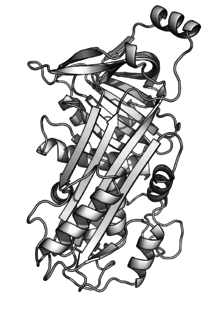Ovalbumin
Ovalbumin (abbreviated OVA[1]) is the main protein found in egg white, making up approximately 55% of the total protein.[2] Ovalbumin displays sequence and three-dimensional homology to the serpin superfamily, but unlike most serpins it is not a serine protease inhibitor.[3] The function of ovalbumin is unknown, although it is presumed to be a storage protein.[4]
| Ovalbumin | |||||||
|---|---|---|---|---|---|---|---|
 | |||||||
| Identifiers | |||||||
| Organism | |||||||
| Symbol | ? | ||||||
| UniProt | P01012 | ||||||
| |||||||
Research
Ovalbumin is an important protein in several different areas of research, including:
- general studies of protein structure and properties (because it is available in large quantities).
- studies of serpin structure and function (the fact that ovalbumin does not inhibit proteases means that by comparing its structure with that of inhibitory serpins, the structural characteristics required for inhibition can be determined).
- proteomics (chicken egg ovalbumin is commonly used as a molecular weight marker for calibrating electrophoresis gels).
- immunology (commonly used to stimulate an allergic reaction in test subjects; e.g., established model allergen for airway hyper-responsiveness, AHR).
(For in vivo and in vitro studies based on ovalbumin it is important that the endotoxin content is less than 1 EU/mg.)
Structure
The ovalbumin protein of chickens consists of 385 amino acids, its relative molecular mass is 42.7 kDa,[5] and it adopts a serpin-like structure.[6] Ovalbumin also has several modifications, including N-terminal acetylation (G1), phosphorylation (S68, S344), and glycosylation (N292).[5] It is secreted from the cell, targeted by an internal signal sequence (residues 21–47), rather than the N-terminal signal sequence commonly found in other secreted proteins. Ovalbumin's signal sequence is not cleaved off, but remains as part of the mature protein.[7]
Change upon heating
When heated, ovalbumin undergoes a conformational change from its soluble, serpin structure into an insoluble all-β-sheet structure with exposed hydrophobic regions. This causes the protein to aggregate and cause the solidification associated with cooked egg white.[8]
See also
References
- Sano Kunio; Kanna Haneda; Gen Tamura; Kunio Shirato (1999). "Ovalbumin (OVA) and Mycobacterium tuberculosis Bacilli Cooperatively Polarize Anti-OVA T-helper (Th) Cells toward a Th1-Dominant Phenotype and Ameliorate Murine Tracheal Eosinophilia". Am. J. Respir. Cell Mol. Biol. 20 (6): 1260–1267. doi:10.1165/ajrcmb.20.6.3546. PMID 10340945. Retrieved 28 December 2011.
- Takehiko Yamamoto, Mujo Kim (1996-12-13), Hen eggs, ISBN 9780849340055
- Hu H.Y., Du H.N. (2000). "Alpha to Beta Structural Transformation of Ovalbumin: Heat and pH Effects". Journal of Protein Chemistry. 19 (3): 177–183. doi:10.1023/A:1007099502179. PMID 10981809.
- Gettins, PGW (2002). "Serpin structure, mechanism, and function". Chemical Reviews. 102 (12): 4751–4804. doi:10.1021/cr010170. PMID 12475206.
- Nisbet, AD; Saundry, RH; Moir, AJG; Fothergill, LA; Fothergill, JE (1981). "The complete amino-acid sequence of hen ovalbumin". European Journal of Biochemistry. 115 (2): 335–45. doi:10.1111/j.1432-1033.1981.tb05243.x. PMID 7016535.
- Stein, Penelope E.; Leslie, Andrew G. W.; Finch, John T.; Carrell, Robin W. (1991-10-05). "Crystal structure of uncleaved ovalbumin at 1·95 Å resolution". Journal of Molecular Biology. 221 (3): 941–959. doi:10.1016/0022-2836(91)80185-W.
- Robinson, A; Meredith, C; Austen, BM (1986). "Isolation and properties of the signal region from ovalbumin". FEBS Letters. 203 (2): 243–246. doi:10.1016/0014-5793(86)80751-7.
- Hu, H. Y.; Du, H. N. (2000-04-01). "α-to-β Structural Transformation of Ovalbumin: Heat and pH Effects". Journal of Protein Chemistry. 19 (3): 177–183. doi:10.1023/A:1007099502179. ISSN 0277-8033. PMID 10981809.
External links
- Ovalbumin at the US National Library of Medicine Medical Subject Headings (MeSH)